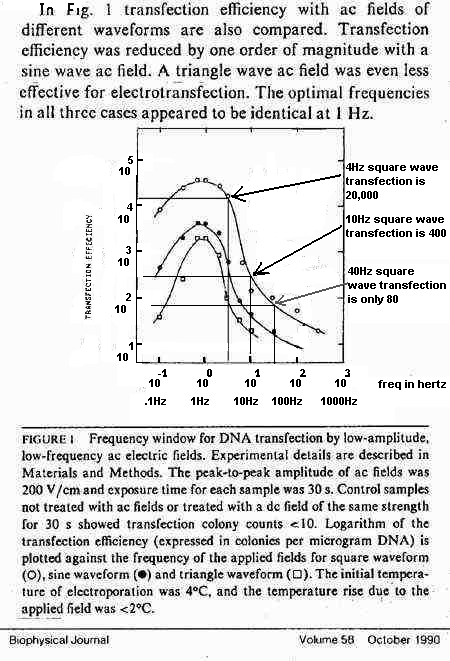TransfectionYou can say you are experiencing transfection when you feel "toxic" from doing 4 Hz blood electrification after ingesting medicine (including aspirin), or smoking, or drinking regular coffee, or drinking an alcoholic drink, or smoking a joint. Actually sometimes you will just feel an amplified effect from the stuff you took, and not really toxic. Either way it is probably hard on your blood cells and so if you use the 4 Hz setting then it should only be used if you haven't ingested any harsh substance for at least 5 hours previous. The useful graph below shows that transfection from high voltage (200v/cm) electroporation is frequency dependant, and that the most affecting frequency is 1 hertz (1 cycle per second). I added the notes on this graph to clarify the frequencies and transfection amounts since the graph is logarithmic. How you translate that is the log number is the number of decimal places you add to 1. Log 0 is 1. Log 1 is 10. Log 2 is 100. Log 3 is 1000. Log -1 is .1. I point out the actual amounts of transfection at the frequencies of 4, 10, and 40 hertz.
It has been pointed out that this graph only shows the transfection with an applied 200 volts per centimeter and that blood electrifiers apply only a small fraction of that. True, but the same research paper said "...electric fields that generate transmembrane potential in the range of millivolts are capable of activating membrane transport systems." The Microbe Electrifier creates a potential across the blood cell membranes of millivolts. Going thru the same paper I also found the following graph that shows that as the voltage is decreased the amount of transfection decreases. Also the frequency that causes the most transfection becomes lower. At 50v/cm (lowest curve) the peak transfection frequency is .1 Hz. And at 10 Hz there is no transfection (if you extend the graph as I did with the dotted line). Even though blood electrifiers deliver much less than 50v/cm I suspect that the transfection graph for a Blood Electrifier is similar although the transfection amounts are less. The fact that blood electrification is done for 1-2 hours daily probably has an effect that makes up for its weakened transfection. This graph shows the transfection produced after only 30 seconds of exposure to electricity.  |
